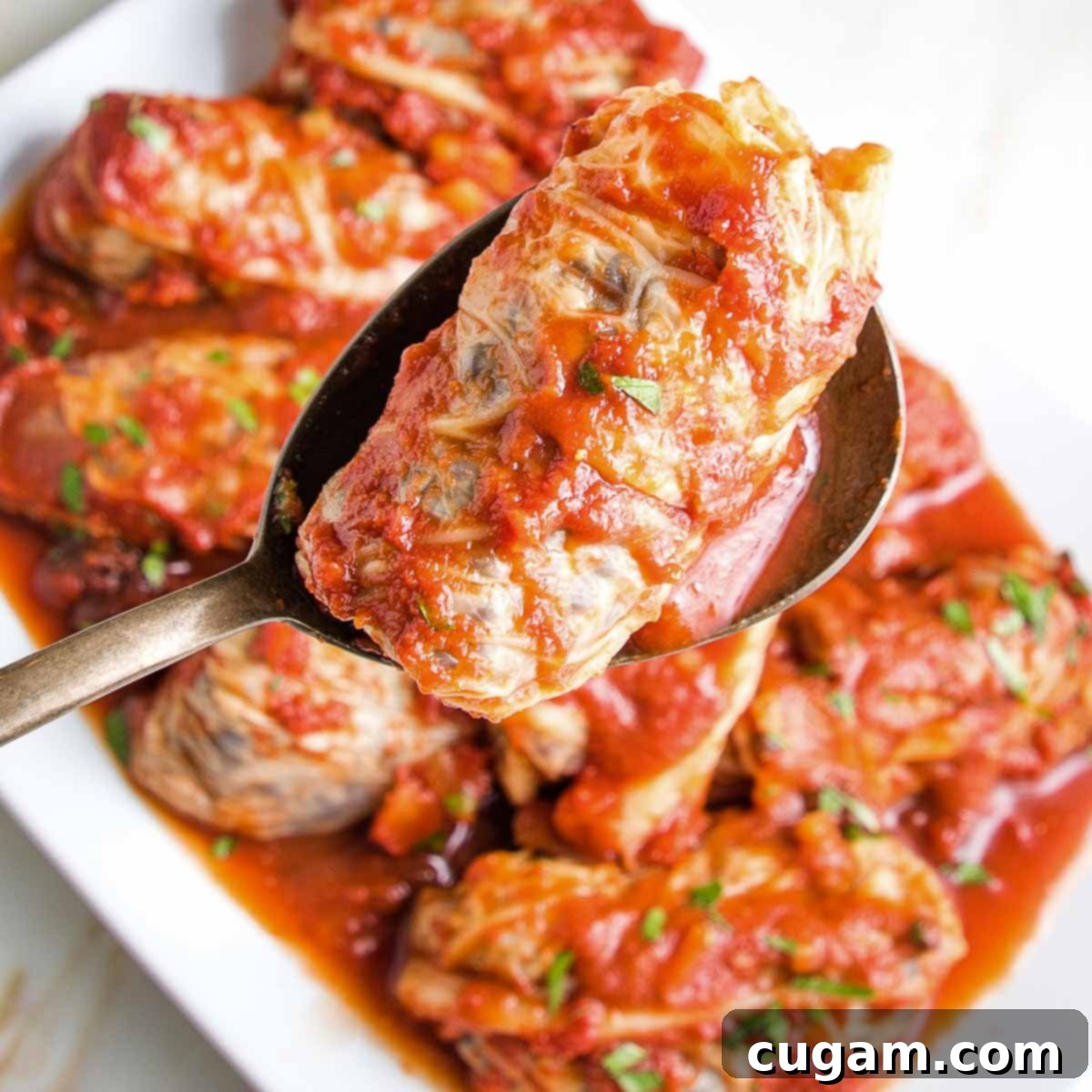The Ultimate Vegan Stuffed Cabbage Rolls: Hearty, Healthy & Flavorful Sweet and Sour Recipe
Prepare to fall in love with these hearty vegan stuffed cabbage rolls, the epitome of healthy comfort food! We’re talking tender cabbage leaves generously filled with a robust mixture of protein-packed lentils and light cauliflower rice, all simmered in a homemade, tangy-sweet and irresistibly delicious sauce. Baked to perfection, this plant-based stuffed cabbage recipe is so flavorful and satisfying that even the most dedicated meat-eaters will be asking for seconds. It truly captures that nostalgic, soul-warming taste – just like Grandma used to make – but without the saturated fat, making it a wholesome choice for any meal.
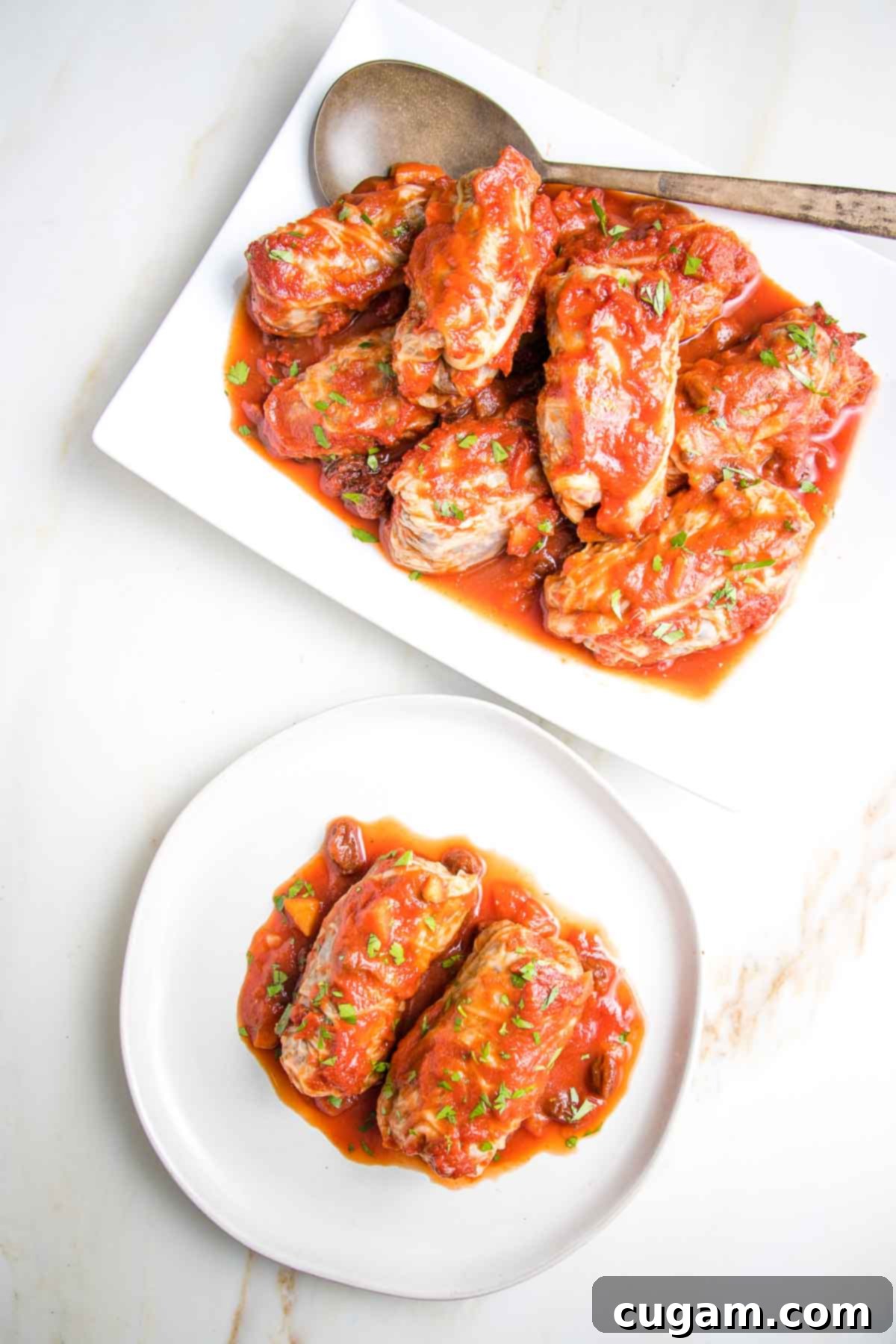
Growing up, my grandmother’s stuffed cabbage was a legendary dish, a culinary masterpiece that always brought our family together. For years, I dreamt of creating a vegan version of these beloved cabbage rolls, but I constantly put it off, convinced it would be an overwhelming task, a labor of love that might not even yield the desired results. I couldn’t have been more mistaken.
Oh my goodness, these vegan stuffed cabbage rolls are not only incredibly delicious but surprisingly straightforward to prepare! They are wonderfully filling and satisfying, yet leave you feeling energized and light, never sluggish. This recipe is an absolute must-try for anyone seeking a wholesome, plant-forward meal that doesn’t compromise on flavor or comfort. Trust me, you need to make them – and soon!
And don’t worry about the process; I’ve gathered all the best tips and tricks to make this a seamless experience. Want to soften your cabbage leaves with minimal fuss? I’ve got an easy freezer method that works like a charm. Looking for a healthy and hearty plant-based filling that’s bursting with flavor? My lentil and cauliflower rice mixture is a winner. Craving a delicious, mouthwatering sweet and sour sauce with just the right amount of tang? We’ll whip up one using simple pantry staples. All the checkboxes are ticked!
The only thing left to do is gather your ingredients, follow these simple steps, and then exercise a little patience. Imagine the heavenly aroma gradually filling your kitchen as these beauties bake to perfection. You’ll have ample time to sit back, relax, and anticipate the moment you get to savor your homemade vegan stuffed cabbage rolls. Who’s ready to dive in?
Why These Vegan Stuffed Cabbage Rolls Are a Must-Try
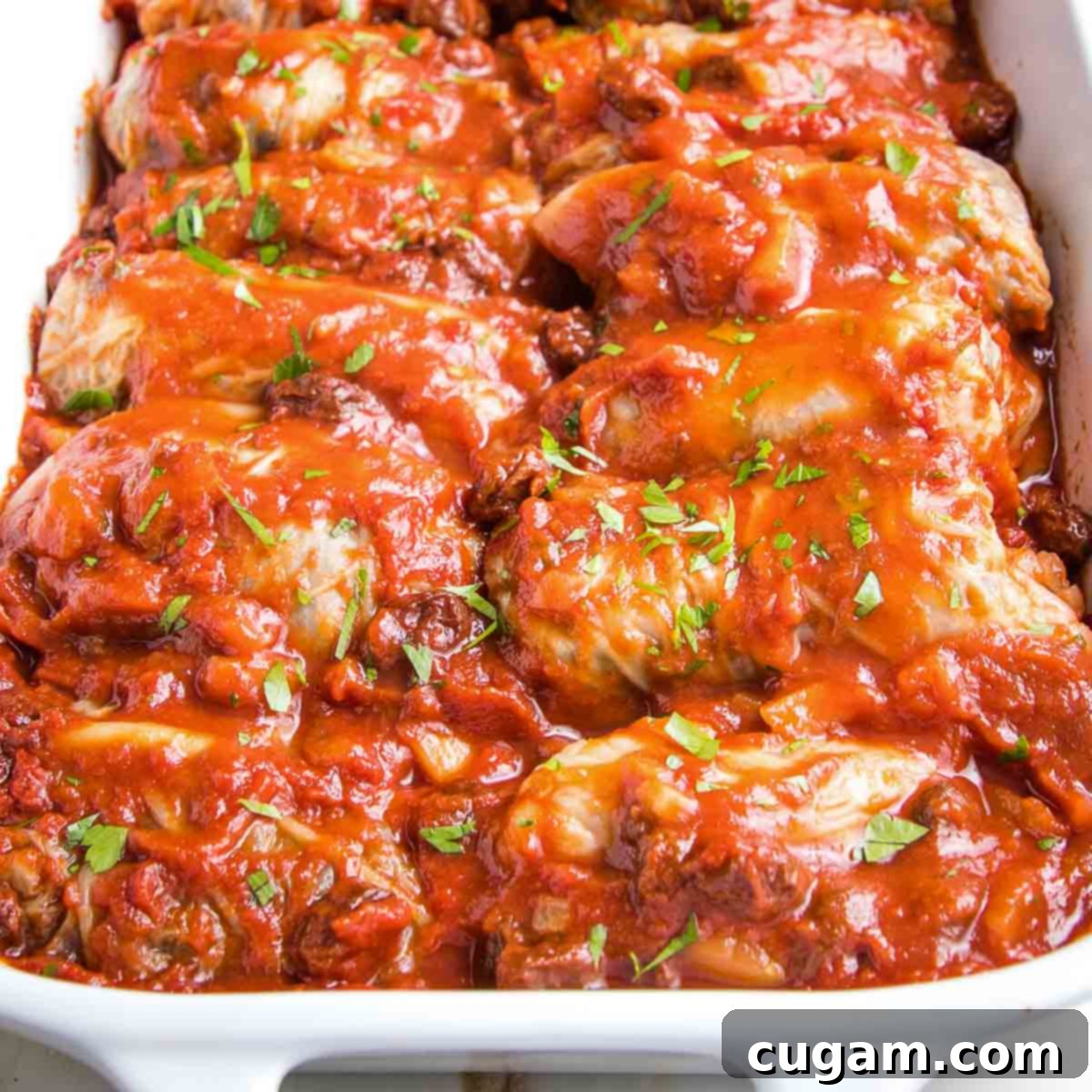
- A Truly Hearty Plant-Based Dinner: This isn’t just a side dish; it’s a complete, satisfying meal. The combination of nutrient-dense lentils, wholesome cauliflower rice, and other fresh vegetables provides a rich source of plant-based protein and fiber, ensuring you feel full and nourished without any heavy ingredients. It’s perfect for satisfying cravings for robust, comforting food.
- Meal Prep Friendly: Life gets busy, and having delicious, ready-to-eat meals on hand is a game-changer. These vegan stuffed cabbage rolls are ideal for meal prepping. You can prepare various components in advance, assemble them when convenient, and then simply reheat portions throughout the week. They taste even better the next day as the flavors meld, making them a fantastic choice for busy weekdays or quick, healthy lunches.
- Tasty, Tangy, Mouthwatering Sauce: The sweet and sour sauce is the star of this dish, striking a perfect balance between sweet, tangy, and savory. Made with readily available pantry ingredients like tomato sauce, pineapple juice, and red wine vinegar, it’s easy to whip up and delivers a vibrant flavor that perfectly complements the earthy cabbage and savory filling.
- Fancy and Easy to Make: Don’t let their elegant appearance fool you. While these stuffed cabbage rolls look impressive enough to grace any special occasion, they are remarkably simple to prepare. The step-by-step instructions and helpful tips ensure that even novice cooks can achieve a show-stopping dish with ease.
- Perfect for Thanksgiving or a Holiday Meal: Looking for a standout vegan option for your holiday spread? These stuffed cabbage rolls are a fantastic choice. They offer a comforting, traditional feel with a modern, plant-based twist, appealing to everyone at the table. Their beautiful presentation makes them a wonderful centerpiece.
- Super Healthy Comfort Food: We all crave comfort food, but often it comes with a side of guilt. Not these! Packed with vegetables, legumes, and whole ingredients, these rolls offer all the warmth and satisfaction of classic comfort food, but in a nutrient-rich, healthy package. You can indulge knowing you’re fueling your body with goodness.
Beyond their incredible taste and health benefits, these vegan stuffed cabbage rolls are also remarkably impressive when served. You don’t have to reveal just how easy they were to make – let your guests believe you’ve toiled away creating something truly special for them! They are absolutely holiday meal-worthy and guaranteed to earn you compliments. It’s our little secret, right?
What Kind of Cabbage is Best for Stuffed Cabbage Rolls?
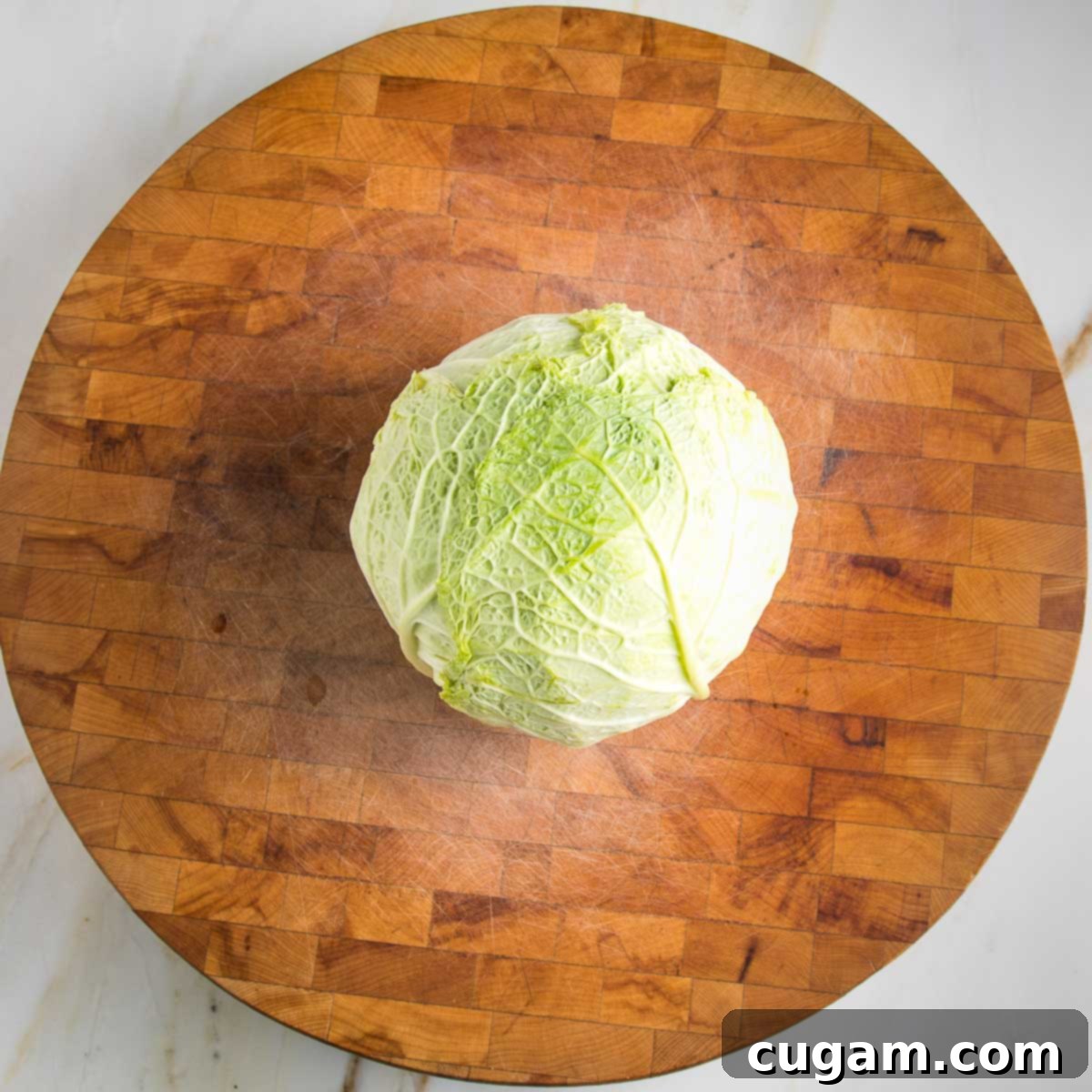
When it comes to crafting the perfect stuffed cabbage rolls, the choice of cabbage is crucial. Traditionally, green cabbage is the go-to variety for its large, sturdy leaves that are easy to roll. While red cabbage can also be used, be aware that its vibrant purple hue tends to darken significantly during cooking, resulting in a less appealing, inky appearance. The flavor, however, remains similar.
My personal favorite, and a highly recommended option for cabbage rolls, is Savoy cabbage. Its distinct, crinkly texture isn’t just visually appealing; it actually contributes to a better rolling experience and a more tender final product. In my experience, Savoy cabbage leaves soften more quickly and become beautifully pliable with less cooking time compared to regular green cabbage. Furthermore, its variegated leaves add a rustic beauty and textural intrigue to the finished dish, elevating its overall presentation and making each bite more interesting.
How to Soften Cabbage for Rolling: Two Easy Methods
Achieving perfectly tender and pliable cabbage leaves is key to successful rolling. Here are two effective methods to prepare your cabbage:
The Freezer Method (My Favorite!)
This method is fantastic for those who like to plan ahead and prefer a hands-off approach. It cleverly uses the power of freezing to achieve beautifully wilted and flexible leaves.
- Why choose the freezer method? If the thought of maneuvering a whole head of cabbage in and out of boiling water seems daunting or messy, this method is your stress-free solution. Freezing works by breaking down the cell walls within the cabbage leaves. As the water inside the cells freezes and expands, it ruptures these structures. When the cabbage defrosts, the leaves naturally wilt and become incredibly pliable and easy to roll, all while releasing excess water. It’s safer, cleaner, and often results in perfectly soft leaves without any risk of overcooking.
- Prep cabbage for freezing: Begin by carefully removing any tough or damaged outer leaves from the cabbage head. Give the cabbage a good rinse under cold water, then pat it thoroughly dry. This step is important because any residual water will simply turn into ice, which can make the defrosting process a bit messier. You do not need to core the cabbage at this stage; it will be much easier to remove the core once the cabbage has softened.
- Place in plastic bag and freeze: The best way to freeze your cabbage is in a sturdy zip-top freezer bag. Before sealing the bag, press out as much air as possible to prevent freezer burn and ensure efficient freezing. If you’re preparing multiple heads of cabbage, freeze each one in a separate bag to facilitate even freezing and easier thawing.
- How long to freeze? For optimal results, freeze the cabbage for at least 1-2 days. You can leave it in the freezer for up to 2 weeks without any issues. This timeframe allows the freezing process to fully work its magic on the leaf structure.
- Thaw cabbage: When you’re ready to make your stuffed cabbage rolls, take the frozen head out a few hours in advance, or ideally, let it thaw overnight at room temperature. It’s crucial to place the head of cabbage on a clean kitchen towel or in a shallow dish, as it will release a significant amount of water as it wilts and softens. Once fully thawed, the leaves will be incredibly tender and ready for rolling. At this point, you can easily remove the core and gently peel off the softened leaves.
The Boiling Method (Traditional & Quick)
For those who prefer a more immediate approach or forgot to freeze their cabbage, the boiling method is a classic and reliable way to soften your leaves.

- Use a chef’s knife and/or a small paring knife to carefully remove the core from the bottom of the cabbage. This makes it easier for the heat to penetrate and for the leaves to peel off later.
- Bring a large pot (at least 4-quart) of water to a rolling boil. Adding a pinch of salt to the water can subtly season the cabbage. Ensure there’s enough water to fully submerge the cabbage head.
- Using a large pair of tongs, carefully place the whole cored cabbage head into the boiling water, core side down. This helps the leaves soften from the inside out.
- Once the water returns to a boil, reduce the heat to a low simmer. You want the leaves to gently cook until tender, not violently boil and tear.
- Cook until the outer leaves become tender and can be easily peeled off without tearing. This usually takes 8-10 minutes, depending on the size and type of cabbage. As leaves soften, gently remove them with tongs, one by one, and continue cooking the remaining head until all usable leaves are pliable.
- Remove the softened leaves from the water with tongs and place them on a clean dish towel or a baking rack to drain and cool. This stops the cooking process and makes them easier to handle. If any leaves have thick central veins, you can carefully trim them down with a paring knife to ensure easier rolling.
The Irresistible Sweet & Sour Sauce
This homemade sweet and sour sauce is what truly elevates these vegan stuffed cabbage rolls, providing a vibrant, tangy, and subtly sweet counterpoint to the savory filling. Made from simple, wholesome ingredients, it’s incredibly easy to prepare and absolutely delicious.
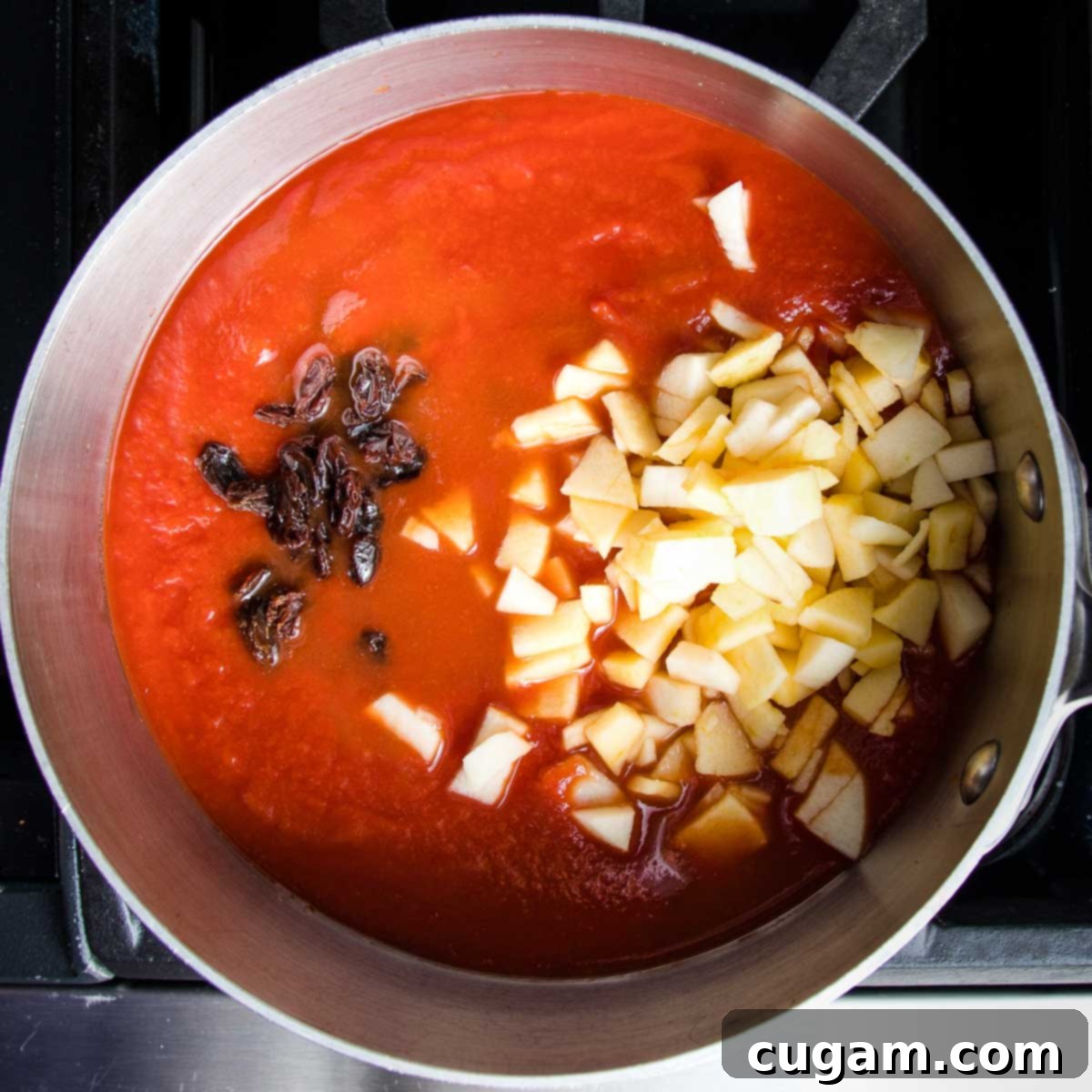
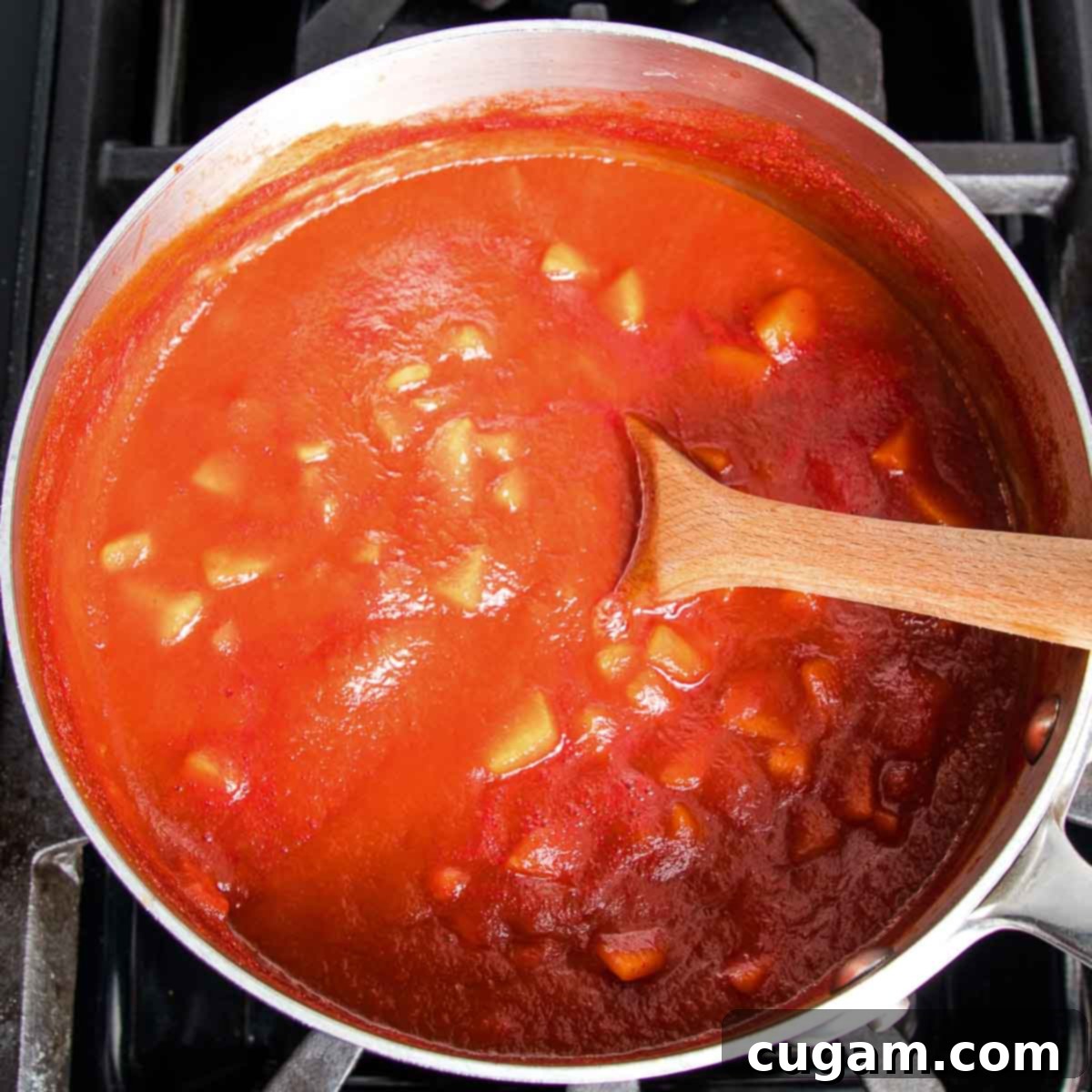
- Tomato sauce: Opt for high-quality organic tomato sauce, preferably sold in glass jars. Look for brands that list only one ingredient: tomatoes. This ensures a pure, rich tomato flavor without added sugars, preservatives, or artificial ingredients, forming the perfect foundation for our sauce.
- Pineapple juice: This ingredient is a secret weapon for achieving that wonderful sweet and tangy balance. I always keep a bottle of pineapple juice in my fridge, not just for this recipe, but also for whipping up delicious dishes like sweet and sour vegan meatballs on a whim. It adds a fruity sweetness and bright acidity that rounds out the sauce beautifully.
- Raisins: Nature’s candy! Raisins are an excellent natural sweetener for this sauce, providing a concentrated burst of fruitiness and a lovely chewiness that develops during simmering. They’re a staple in my pantry, often used to make my favorite oatmeal raisin cookies.
- Apples: Fresh apples are a wonderful addition to the sauce. I particularly love the way small chunks of apple soften and absorb the flavors of the sauce as they cook, adding a subtle sweetness and textural contrast. If you prefer a smoother sauce or a more subtle apple flavor, you can grate the apples instead of dicing them.
- Red wine vinegar: This is our primary source of tanginess, cutting through the sweetness and richness of the tomatoes and fruit. It adds a sophisticated depth of flavor. If you don’t have red wine vinegar on hand, good substitutes include lemon juice, apple cider vinegar, unseasoned rice vinegar, or white wine vinegar. Each will offer a slightly different nuance but will provide the necessary acidity.
The Hearty Plant-Based Filling
The star of our vegan stuffed cabbage rolls is this incredibly flavorful and nutritious plant-based filling. It’s packed with wholesome ingredients that create a satisfying texture and rich taste, making each bite truly enjoyable.
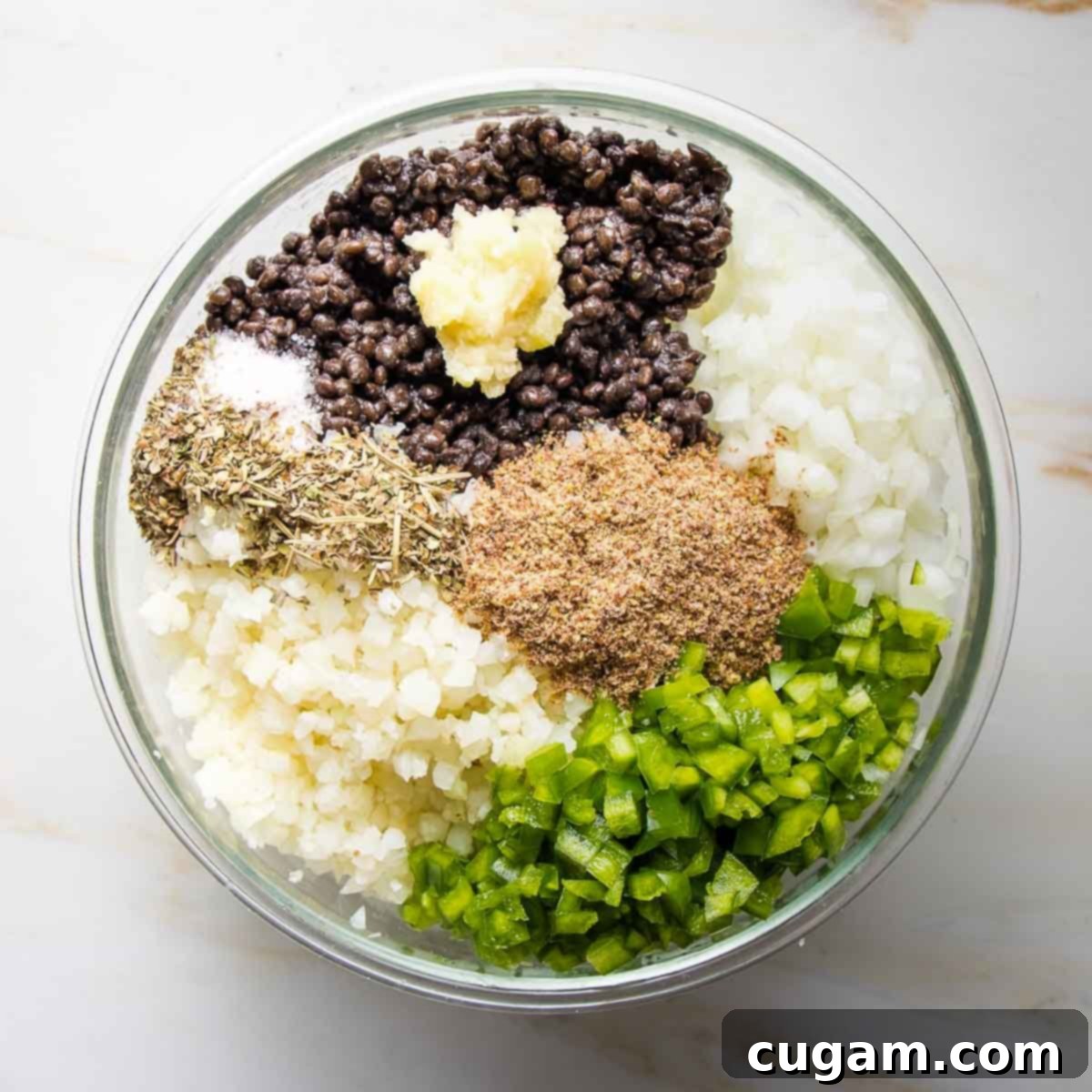
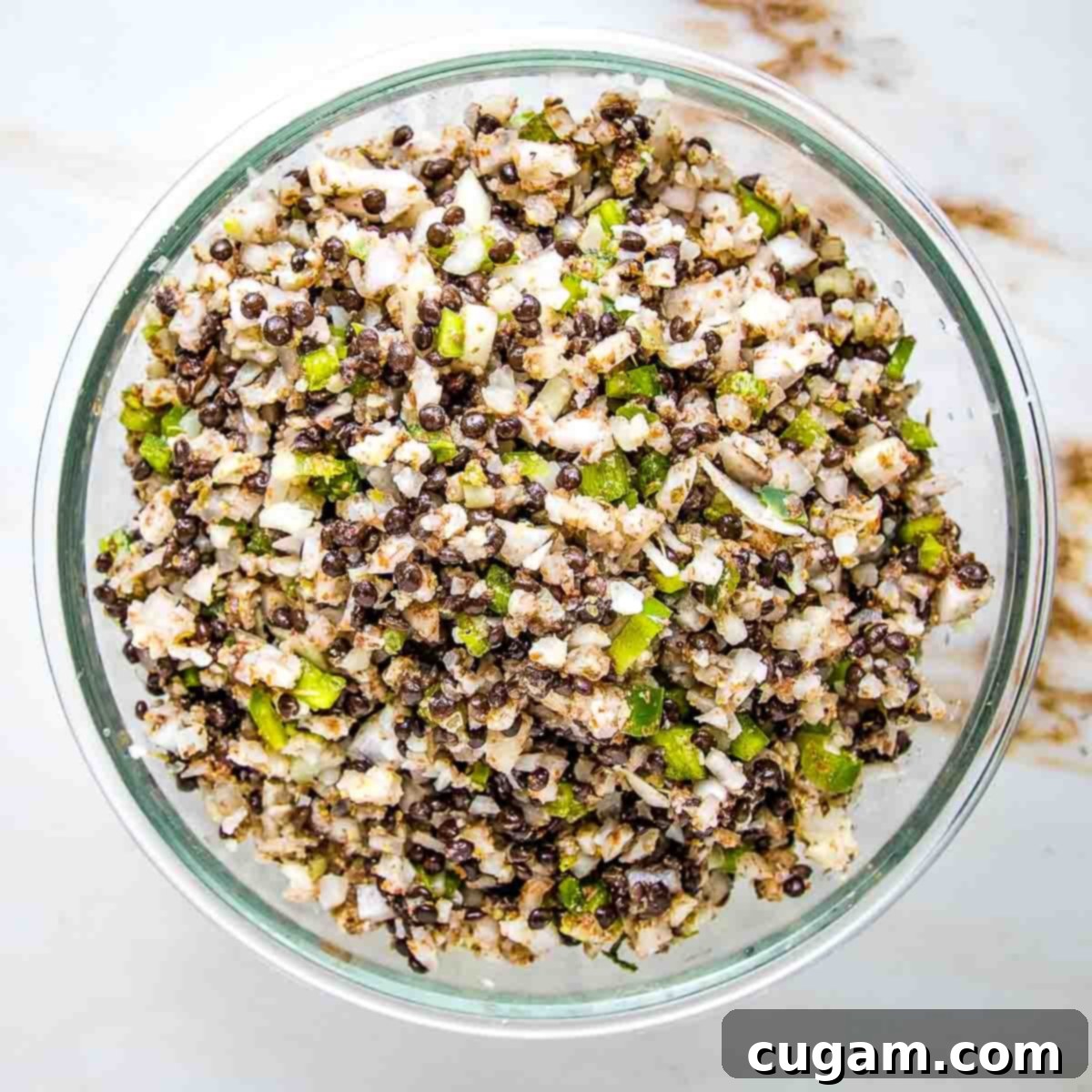
- Legumes: I prefer using cooked lentils for their fantastic plant-based protein content and a generous boost of dietary fiber. They have a wonderful texture that holds up well in the filling. If lentils aren’t your preference, cannellini beans or pinto beans are also excellent choices. They are soft enough to be easily mashed and incorporated into the rest of the ingredients, adding a creamy texture and their own unique flavor profile. Make sure your lentils are cooked al dente, not mushy.
- Quick and Easy Mixing: One of the best parts about this filling is how quickly it comes together. It takes just a couple of minutes to combine the finely chopped onions, vibrant green peppers, nutritious cauliflower rice, binding ground flax seeds, aromatic fresh garlic, and a blend of savory spices with your chosen legumes. The flax seeds act as a natural binder, helping the filling stay together inside the cabbage leaves.
- No Need to Pre-Cook the Filling: This is a major time-saver! There’s no need to cook the filling mixture before stuffing the cabbage rolls. As the stuffed cabbage bakes in the oven, the moist environment and the gentle heat will steam the filling from within. This slow cooking process allows all the flavors to meld beautifully, infusing the vegetables and lentils with the spices and making the filling incredibly rich, tender, and intensely flavorful. It’s a testament to simple ingredients transforming into something extraordinary.
How to Stuff and Fold Cabbage into Perfect Rolls
The art of rolling cabbage can seem tricky at first, but with a little practice, you’ll be creating perfectly uniform rolls in no time. The key is to start with well-softened leaves and a consistent amount of filling.
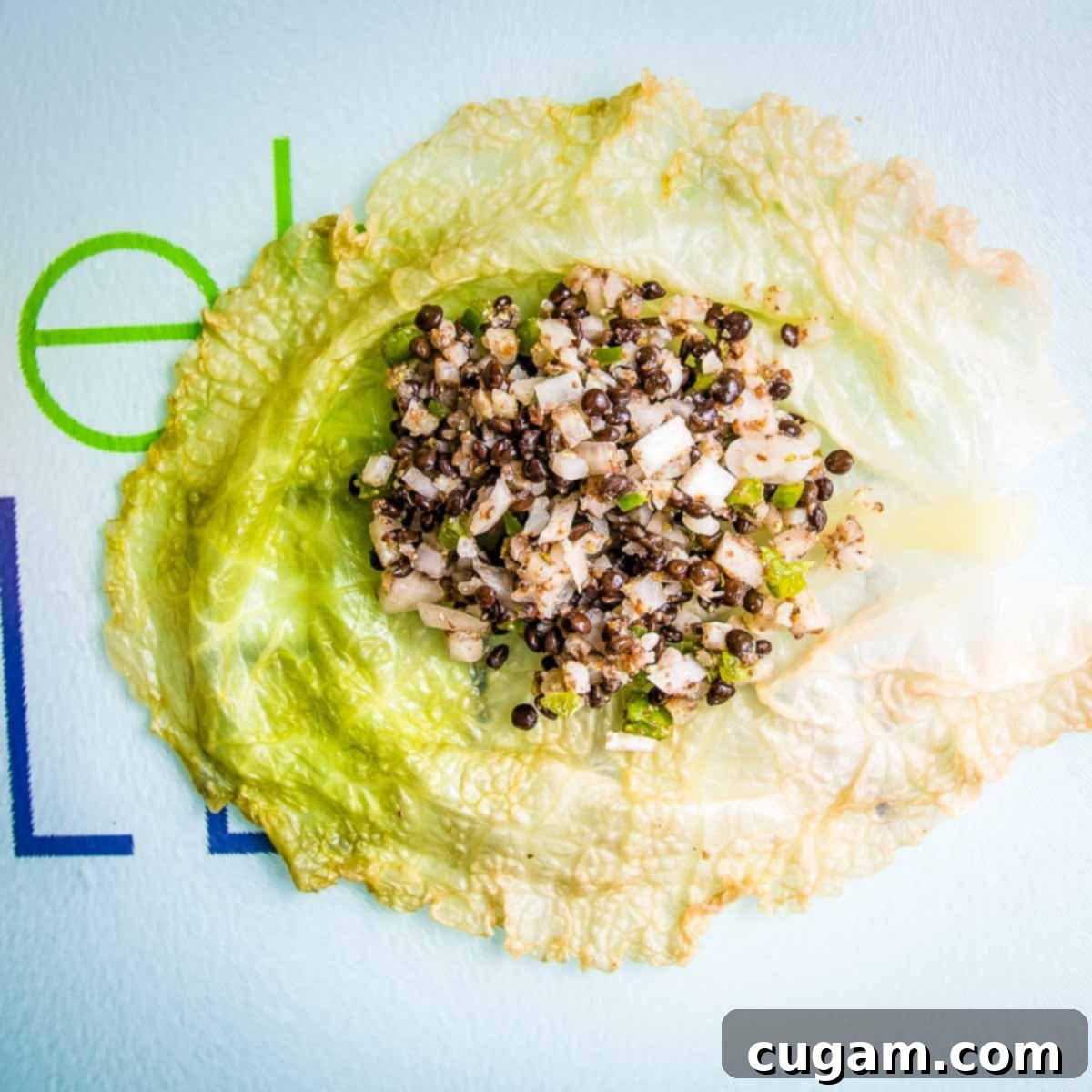
Step 1: Position the Leaf. Place a softened cabbage leaf on a clean, flat surface, with the stem end facing towards you. If the central vein is too thick, gently trim it down to ensure easy rolling without tearing the leaf.
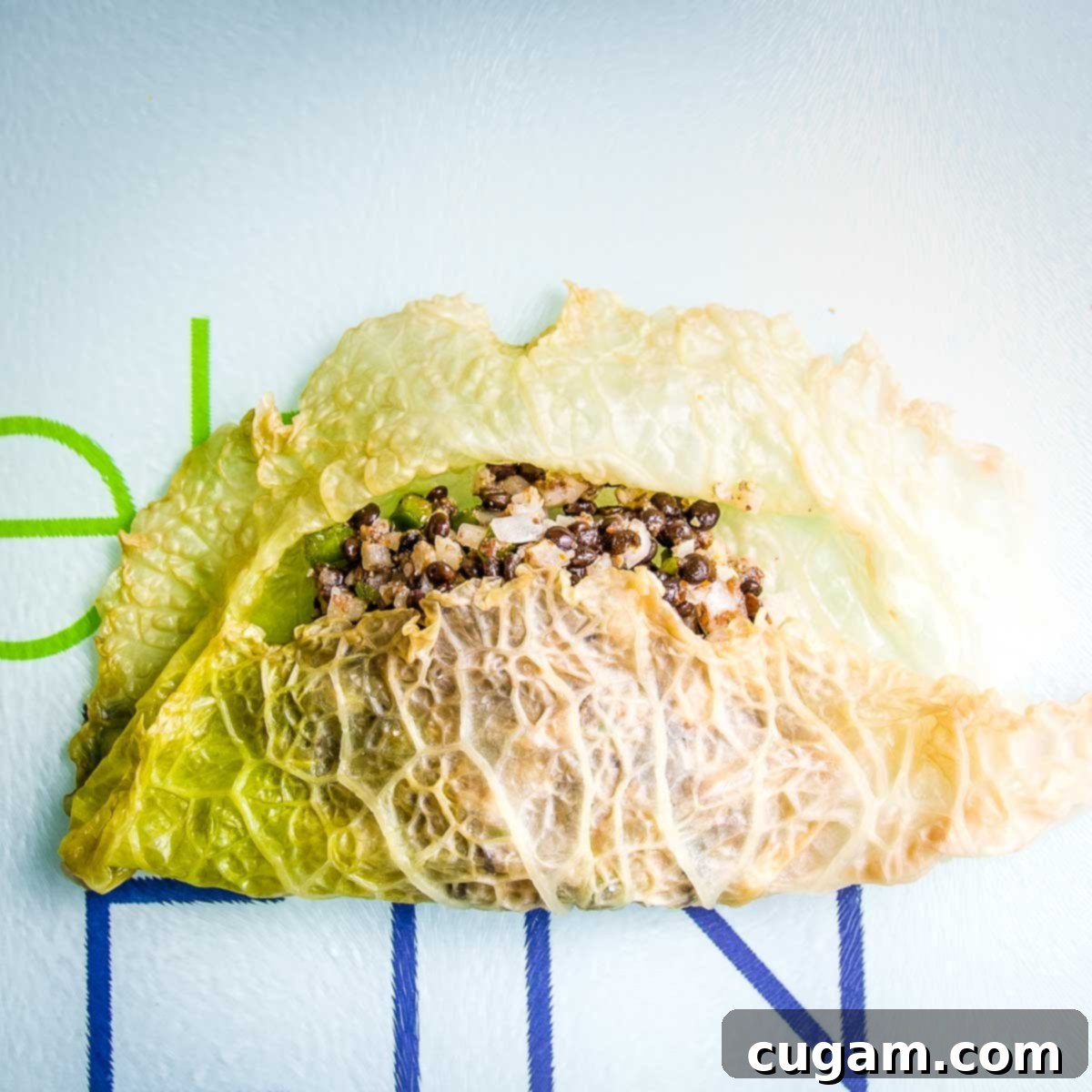
Step 2: Add the Filling. Spoon a heaping tablespoon (or 1-2 tablespoons, depending on leaf size) of the plant-based filling onto the center of the leaf, closer to the stem end. Avoid overfilling, as this will make rolling difficult.
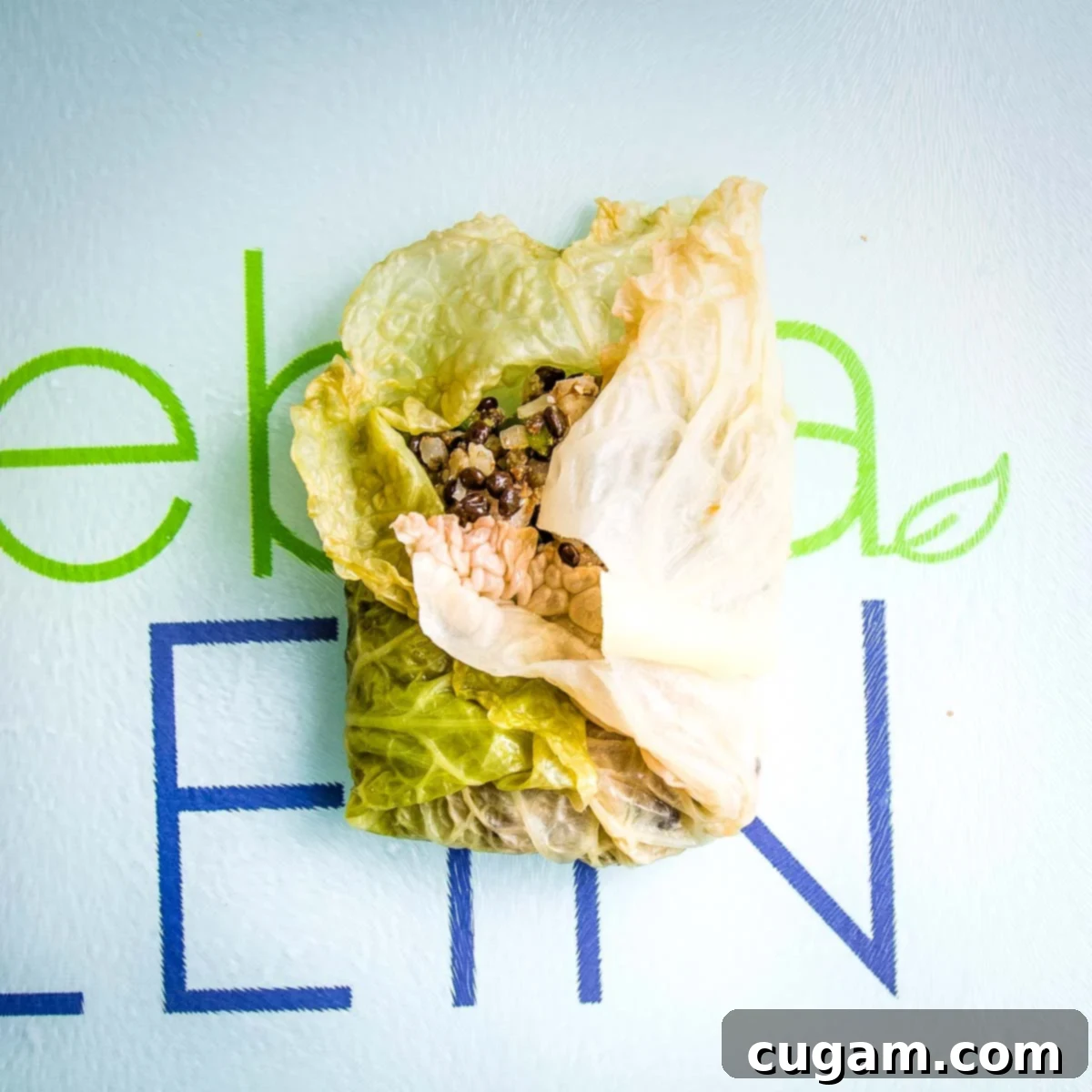
Step 3: Fold the Bottom. Fold the bottom edge of the cabbage leaf up over the filling, tucking it in snugly. This creates the initial base of your roll.

Step 4: Fold the Sides. Next, fold both side edges of the leaf inwards towards the center, overlapping them slightly to enclose the filling tightly. This prevents the filling from spilling out during baking.
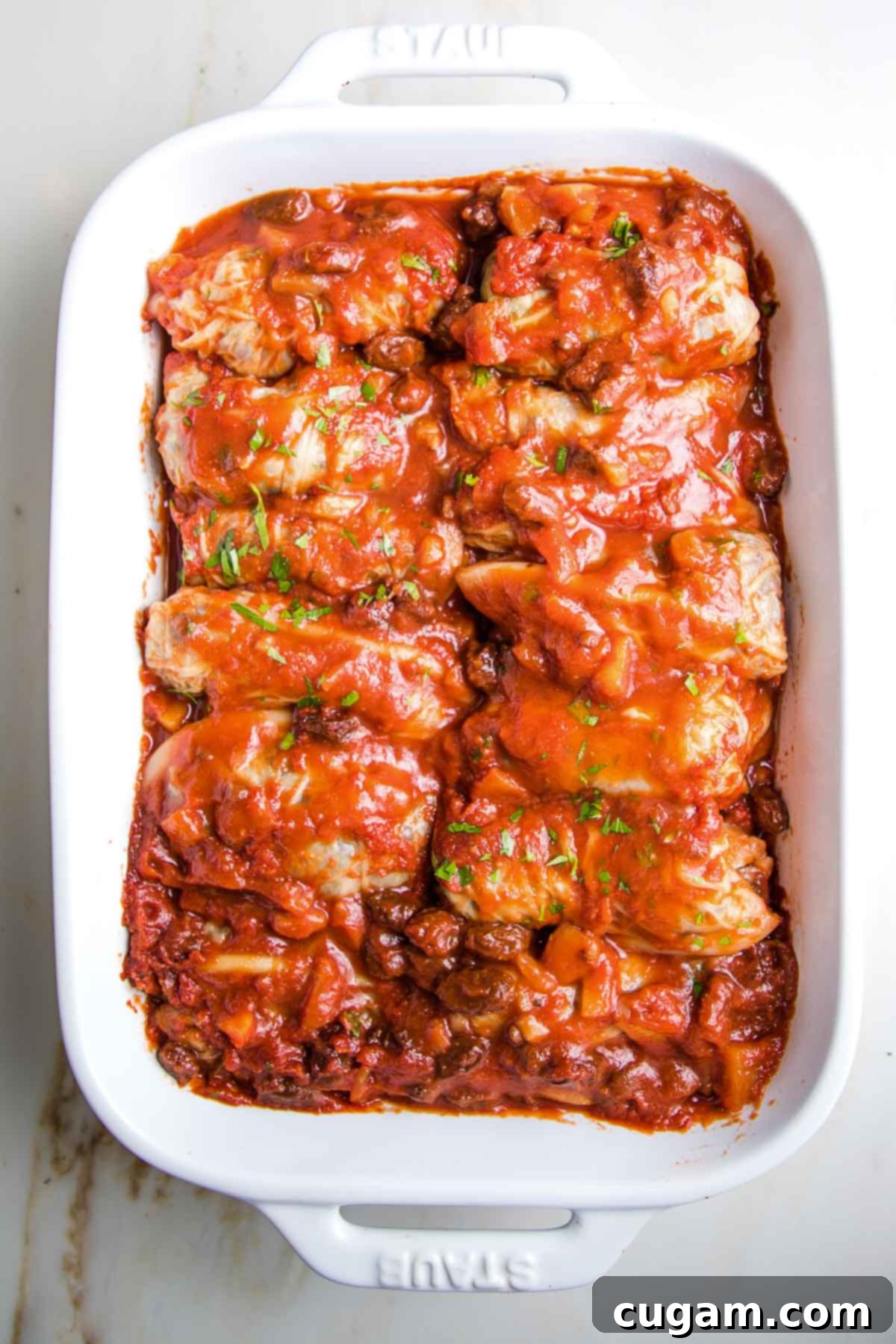
Step 5: Roll it Up. Starting from the bottom (the side closest to you), tightly roll the entire cabbage leaf upwards towards the top. Aim for a compact, neat log. Place the finished cabbage roll seam-side down to keep it intact.
Repeat this process with the remaining leaves and filling until all your delicious vegan stuffed cabbage rolls are prepared and ready for baking. The goal is to make them as uniform as possible for even cooking and presentation.
Prep Cabbage Rolls for Baking: Layering for Perfection
Once your individual cabbage rolls are expertly filled and folded, it’s time to arrange them in a baking dish and prepare them for their journey to tender, flavorful perfection in the oven.
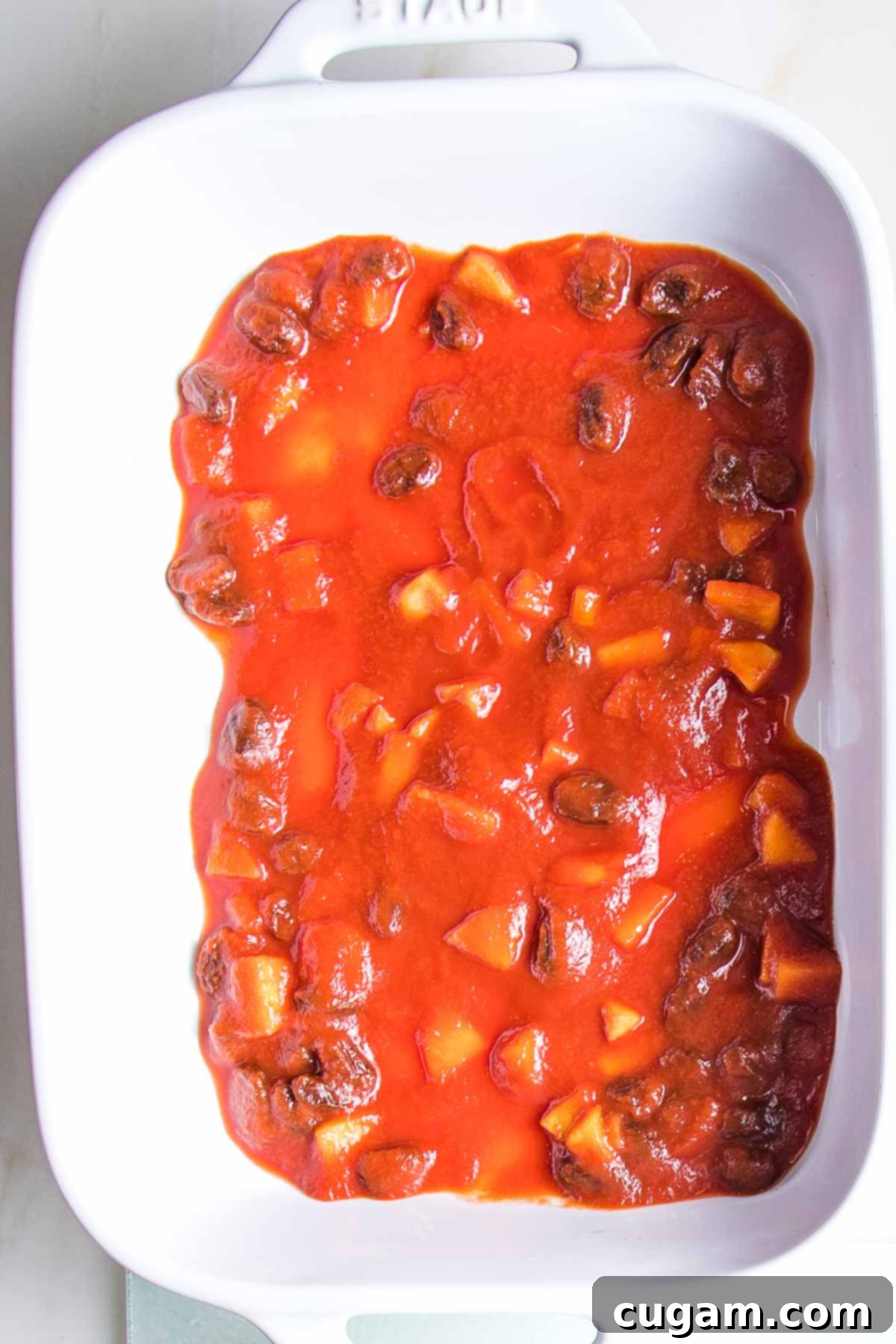
Step 1: Sauce the Bottom. Begin by spreading about ¾ cup of your sweet and sour sauce evenly over the bottom of a deep baking dish (a 3-quart dish is ideal for a standard batch). This layer of sauce prevents the rolls from sticking and infuses the bottom with flavor from the start.
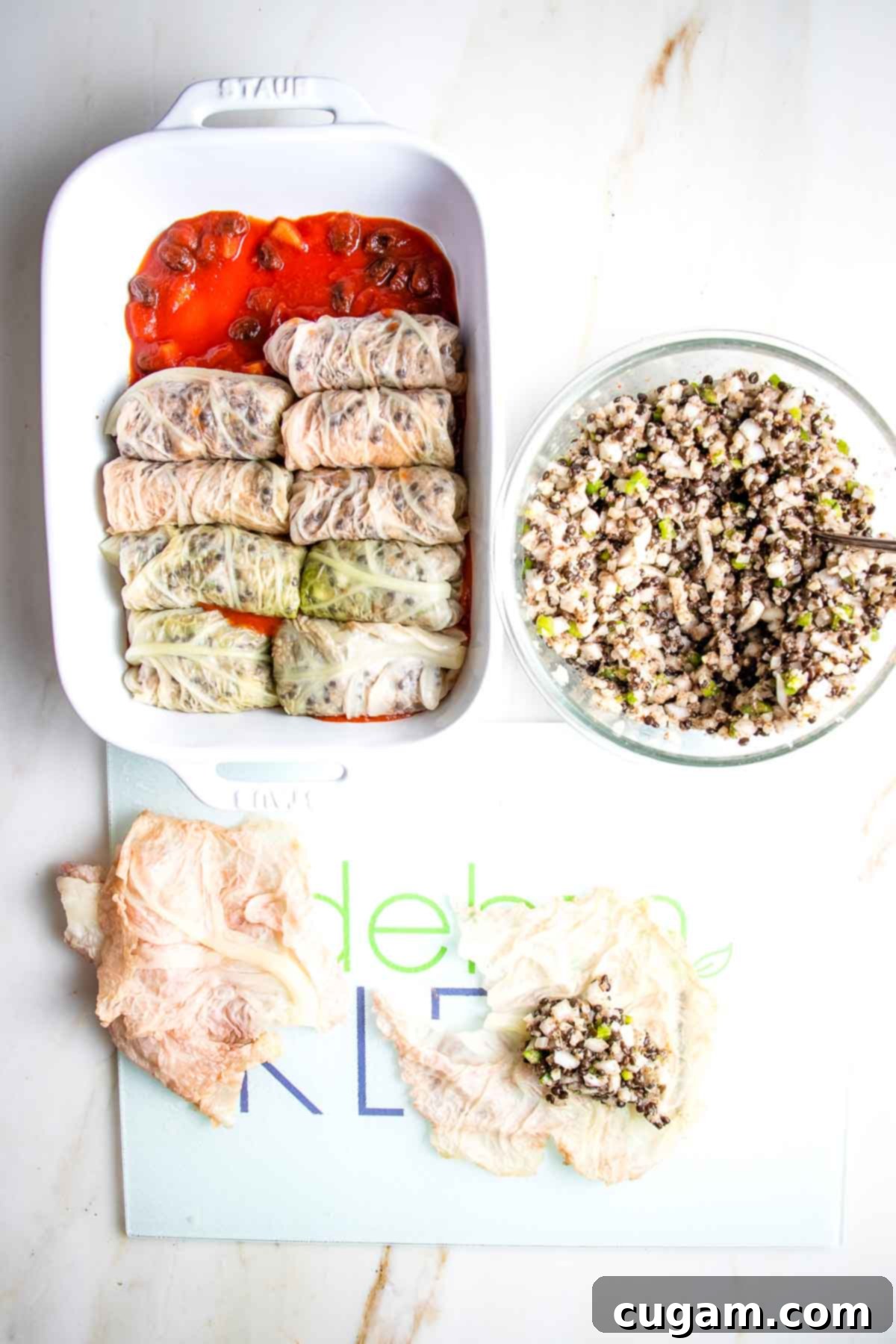
Step 2: Arrange the Rolls. Carefully place each rolled cabbage leaf, seam-side down, onto the sauce in the baking dish. Arrange them snugly next to each other in a single layer. This close placement helps them hold their shape and steams them effectively during baking. If you have a larger batch, you can create a second layer, ensuring each roll still has some contact with the sauce.
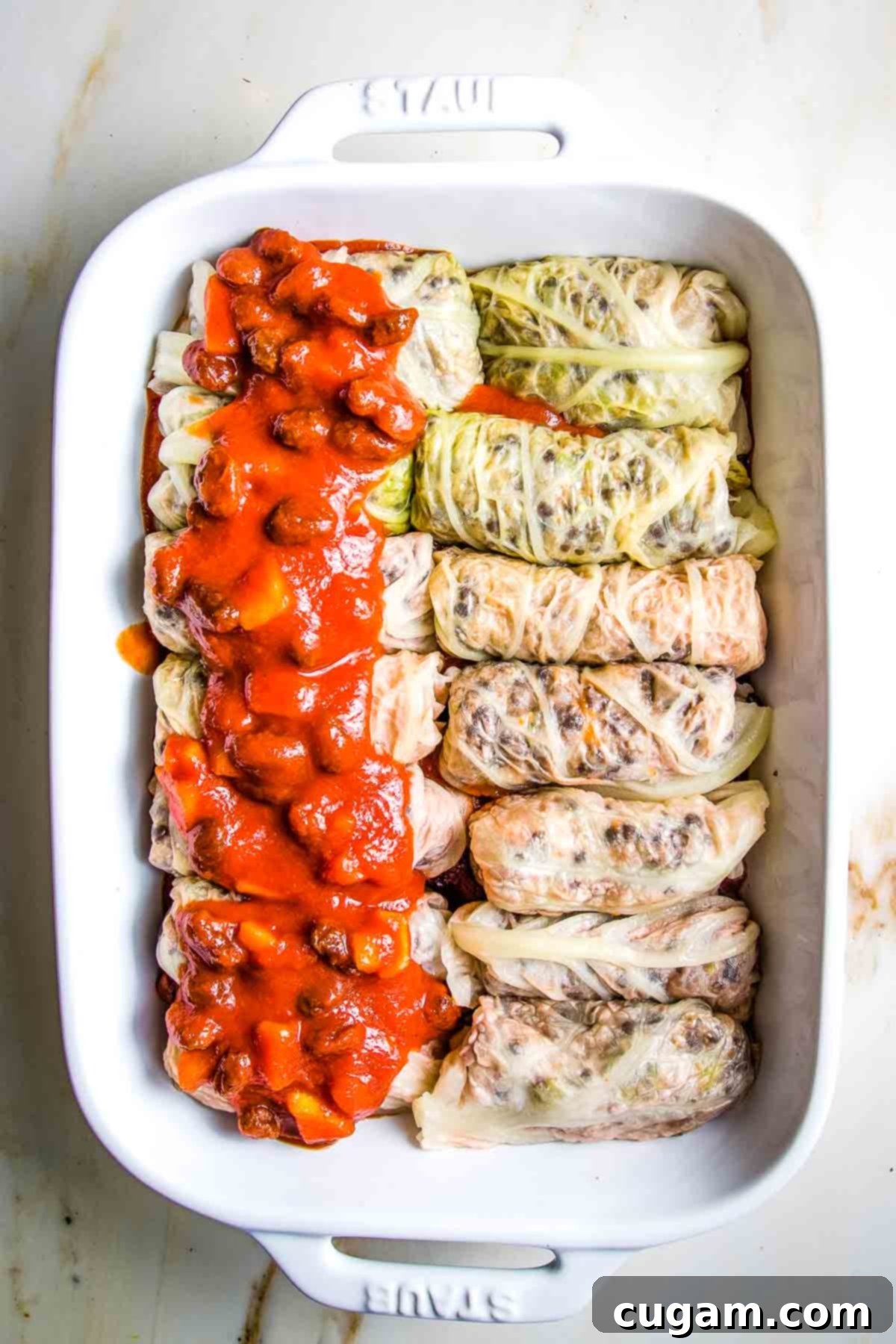
Step 3: Top with Sauce and Liquid. Once all the cabbage rolls are in the dish, spoon the remaining sweet and sour sauce generously over them, ensuring they are well-covered. Then, pour ¾ cup of water (or vegetable broth for added flavor) over the entire dish. This liquid is essential for creating a steamy environment in the oven, which helps the cabbage become incredibly tender and allows the filling to cook through and absorb all the delicious flavors.

Step 4: Bake to Perfection. Cover the baking dish tightly with aluminum foil or a fitted lid. This creates that crucial steamy environment. Transfer the covered dish to a preheated 350-degree Fahrenheit (175°C) oven and bake for approximately 90 minutes, or until the cabbage leaves are wonderfully soft and the filling is thoroughly cooked and fragrant. The aroma that fills your kitchen during this baking time will be absolutely intoxicating!

Once baked, these beautiful vegan stuffed cabbage rolls emerge tender, juicy, and coated in their vibrant sauce. Allow them to rest for a few minutes before serving, then garnish with fresh herbs if desired for an extra touch of freshness and color. Enjoy this truly comforting and incredibly satisfying plant-based meal!
Debra’s Pro Tips for Vegan Stuffed Cabbage Success
Making stuffed cabbage can seem like a project, but with these expert tips, you’ll find the process much smoother and more enjoyable, guaranteeing perfect results every time.
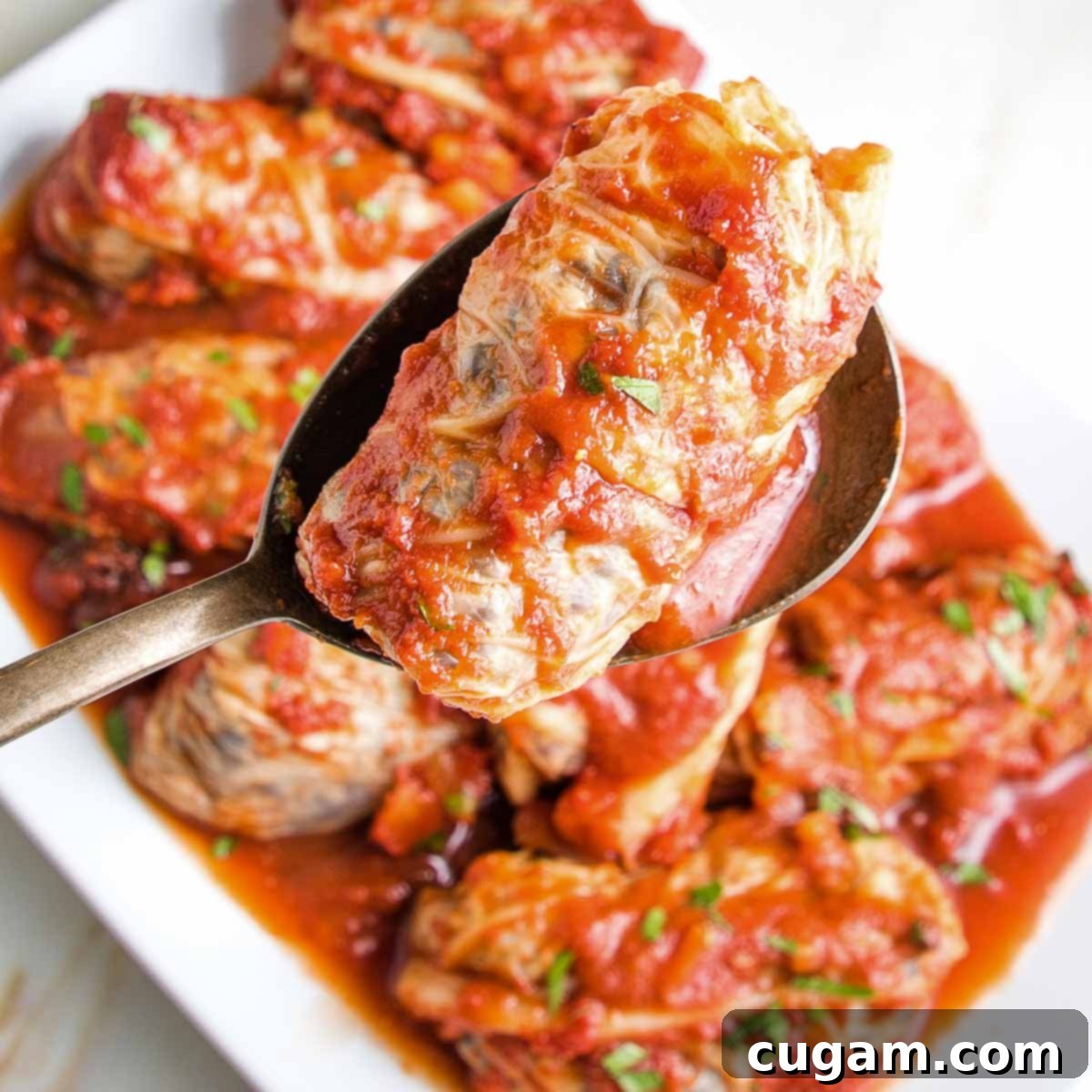
- Don’t be alarmed at the TOTAL time to make these: While the overall recipe time might look lengthy, a significant portion of it is passive cooking time in the oven. The hands-on prep work is actually quite manageable. Think of it as an opportunity to relax while your kitchen fills with incredible aromas, knowing a delicious meal is cooking itself.
- A large head of cabbage has enough leaves to make a double batch: This is a fantastic strategy for efficiency. If you’re going through the effort of softening cabbage leaves, take advantage of a larger head. You’ll likely get enough usable leaves to create two full baking dishes of rolls – one to enjoy right away and another to freeze for a future busy weeknight meal. It’s like cooking once and eating twice!
- In a rush? Use convenience ingredients: We all have those days when time is short but the craving for homemade food is strong. On such occasions, don’t hesitate to reach for pantry shortcuts. Use canned lentils (rinsed and drained) instead of cooking them from scratch, and opt for pre-packaged frozen cauliflower rice. These small adjustments can dramatically cut down on your prep time, allowing you to quickly mix the filling and assemble your rolls without compromising too much on flavor or nutrition.
- Trim thick veins for easier rolling: Even after softening, some cabbage leaves might have a very thick central vein. Taking a moment to carefully trim this down with a sharp paring knife or kitchen shears will make the leaves much more flexible and easier to roll tightly, preventing tears and ensuring a neat, compact roll.
- Taste and adjust the sauce: Before adding the sauce to the baking dish, give it a quick taste. Depending on the sweetness of your apples or raisins and the acidity of your vinegar, you might want to adjust it slightly. A tiny pinch of sugar or a splash more vinegar can make a big difference in achieving your ideal sweet and sour balance.
Meal Prep and Storage for Vegan Stuffed Cabbage Rolls
These vegan stuffed cabbage rolls are a dream for meal prep, allowing you to enjoy healthy, homemade comfort food even on your busiest days. Here’s how to prepare them ahead and store them effectively:
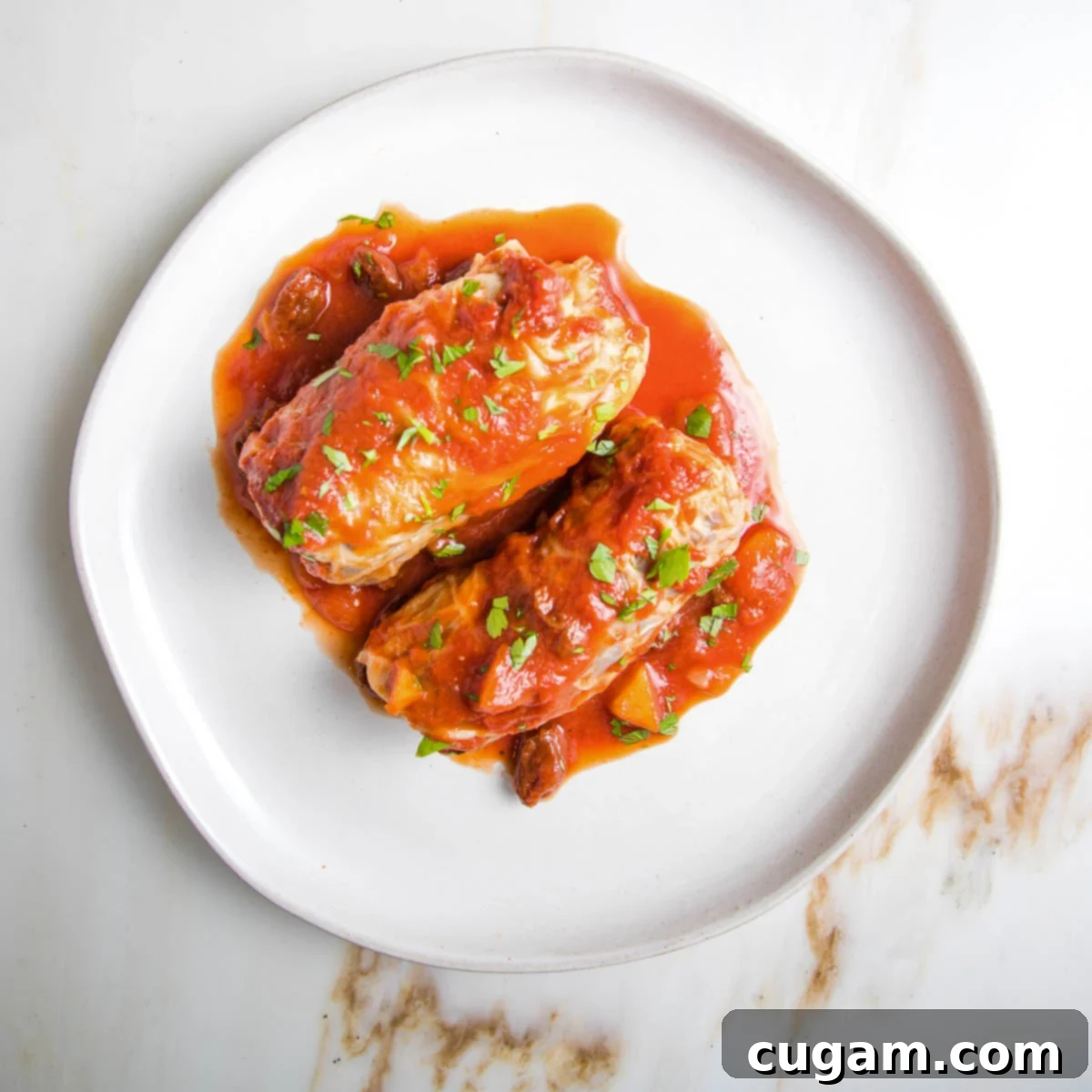
- Prep Ahead:
- Filling: The plant-based filling can be prepared up to a week in advance. Store it in an airtight container in the refrigerator, ready to be scooped into your cabbage leaves.
- Sauce: The sweet and sour sauce can also be made ahead of time and kept in an airtight container in the fridge for up to a week. Its flavors will deepen beautifully.
- Cabbage: If using the freezer method, freeze your cabbage head up to two weeks in advance. Defrost it in the refrigerator overnight the day before you plan to assemble your rolls for perfectly soft leaves.
- Store Cooked Cabbage Rolls: Once baked, any leftover stuffed cabbage casserole should be allowed to cool completely. Then, transfer it to an airtight container or cover the baking dish tightly with plastic wrap and foil. It will keep beautifully in the refrigerator for up to 5 days. The flavors often deepen and improve overnight!
- Freeze Cooked Cabbage Rolls: Stuffed cabbage rolls freeze exceptionally well, making them perfect for future meals.
- I love using glass containers with tight-fitting lids for freezing casseroles, as they are freezer-to-oven safe and prevent freezer burn.
- Alternatively, you can cool the entire baking dish of cooked rolls completely, then cover it tightly with a double layer of aluminum foil. Freeze for up to 3 months.
- To thaw, transfer the frozen dish or individual portions to the refrigerator and let them defrost overnight.
- Reheat:
- From Refrigerator (cooked): Reheat individual portions in the microwave until warm, or place the covered baking dish in a preheated 350-degree Fahrenheit (175°C) oven for about 30 minutes, or until heated through.
- From Freezer (cooked and defrosted): Reheat similarly to refrigerated rolls, ensuring they are thoroughly warmed to the center. If reheating from frozen (not recommended for best results, but possible), add extra liquid (broth or water) and cover tightly, baking at a lower temperature (e.g., 300°F/150°C) for a longer period (60-90 minutes) until heated through and tender.
Did you know commenting and rating recipes is one of the best ways to support your favorite food bloggers? If you made this recipe, please consider a five-star rating below and leave a comment sharing your experience. Also, we’d love to see your creations! Please share your photos on Instagram by tagging me @dkhealthcoach and using the hashtag #debraklein. Your support means the world!
📖 Recipe

Vegan Stuffed Cabbage Rolls
Rate this Recipe
Pin Recipe
Equipment
-
3 quart baking dish
-
Glass Mixing Bowls with Lids
-
Sauce Pan with Lid
Ingredients
- 1 head cabbage green or savoy
Sweet and sour sauce
- 2 15-oz cans tomato sauce
- ½ cup raisins
- 2 small apples peeled and diced small or shredded
- ¼ cup red wine vinegar*
- ½ cup pineapple juice
Filling
- 1 ½ cups cooked lentils*
- 1 medium onion grated or finely diced
- 1 small green pepper small dice
- 1 cup cauliflower rice
- ¼ cup ground flax seeds
- 3 cloves garlic pressed
- 1 Tablespoon dried Italian spices
- ½ teaspoon coarse sea salt
Instructions
-
PREPARE (SOFTEN) CABBAGE: Pull off any tough or damaged outer leaves from the cabbage. Rinse the head of cabbage thoroughly and pat it dry.
Freezer Method: Place the cleaned cabbage head into a large zip-top freezer-safe bag, removing as much air as possible before sealing. Freeze for 2-3 days, or up to 2 weeks. When ready to use, defrost the cabbage at room temperature for a few hours, or ideally, overnight. As it defrosts, the cabbage will naturally wilt and release water (I recommend placing it on a dish towel or in a shallow dish). Once fully thawed and soft, carefully cut off the stem and gently remove the pliable leaves. If necessary, trim any excessively thick central veins with kitchen shears or a sharp paring knife to make rolling easier. -
Cook lentils according to package directions until tender but still holding their shape (al dente). This step can be done up to 3 days in advance and stored in the fridge. This recipe calls for already cooked lentils.
-
MAKE THE FILLING: In a large mixing bowl, combine the cooked lentils, grated or finely diced onions, small-diced green peppers, cauliflower rice, ground flax seeds, pressed garlic, and dried Italian spices. Season with ½ teaspoon coarse sea salt. Mix all ingredients thoroughly until well combined. If using canned beans instead of lentils, mash them slightly with a fork before blending with the remaining ingredients.
-
MAKE THE SAUCE: In a medium saucepan, combine the tomato sauce, raisins, diced or shredded apples, red wine vinegar, and pineapple juice. Bring the mixture to a gentle simmer over low heat and let it cook for about 15 minutes, allowing the flavors to meld and the apples to soften slightly. Taste and adjust seasonings if desired.
-
Preheat your oven to 350°F (175°C).
-
Spread approximately ¾ cup of the prepared sweet and sour sauce evenly over the bottom of a deep 3-quart casserole dish.
-
STUFF AND ROLL CABBAGE: Lay a softened cabbage leaf flat on a clean surface. Spoon 1-2 tablespoons of filling onto the center of the leaf, closer to the stem end. Fold the bottom edge of the cabbage leaf up over the filling, then fold in both sides towards the center. Finally, roll the leaf tightly from the bottom to the top to form a neat log. Place the rolled cabbage leaf, seam-side down, onto the sauce in your casserole dish.
-
Continue to stuff and roll the remaining leaves, arranging them snugly in the casserole dish until it is full. Lightly sprinkle the rolls with a little extra salt and pepper if desired. Pour the remaining sweet and sour sauce evenly over all the cabbage rolls. Finally, pour ¾ cup of water (or vegetable broth) over the entire dish. Cover the casserole dish tightly with aluminum foil or a fitted lid and bake in the preheated oven for 90 minutes, or until the cabbage is very tender and the filling is cooked through.
Notes
ALTERNATE METHOD TO SOFTEN CABBAGE LEAVES (Boiling Method): If you didn’t have time to plan ahead and use the freezer method, you can quickly boil the cabbage to soften it. Use a large 4-quart pot or larger, filling it at least halfway with water (ensure enough water to fully cover the cabbage when submerged) and bring it to a rolling boil. Carefully remove the core from the cabbage. Gently place the whole cored head into the boiling water, core side down. Reduce the heat to a low simmer and cook until the outer leaves soften, which typically takes about 15 minutes. As the leaves become tender, remove them one by one from the pot with tongs. Continue simmering and peeling until you have enough pliable leaves. Drain them on a clean towel.
STORAGE AND FREEZING: Baked stuffed cabbage rolls will stay fresh and delicious in an airtight container in the fridge for up to 5 days. For longer storage, you can freeze them for up to 3 months. To freeze, allow the cooked casserole to cool completely. You can freeze it in the baking dish, tightly covered with foil, or transfer individual rolls to freezer-safe containers. To reheat, defrost frozen rolls overnight in the fridge. Then, reheat in a preheated 350-degree Fahrenheit (175°C) oven for about 30 minutes, or until heated through.
Nutrition
Note
The nutrition calculations were done using online tools. To obtain the most accurate representation of the nutritional information in any given recipe, you should calculate the nutritional information with the actual ingredients you used. You are ultimately responsible for ensuring that any nutritional information is accurate, complete and useful.
